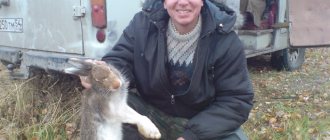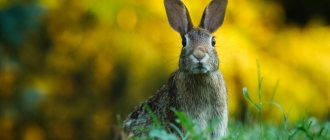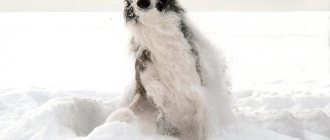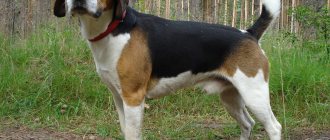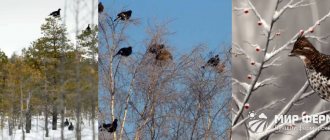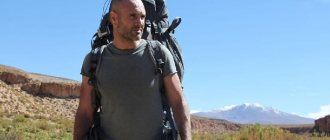It was customary to hunt hares in our area back in ancient times, because these animals are extremely common in many regions, regardless of climatic conditions. In most cases, you don’t even need a permit to hunt a hare, because the population of these animals is large and rarely drops to a critical level.
It should be borne in mind that, despite the popularity of such active recreation, it will not be so easy to get game, because hares are distinguished by amazing speed and caution, so it is extremely difficult to get close to them unnoticed. However, armed with certain theoretical knowledge and developing the necessary skills, you will be able to get the desired trophy.
- Equipment
- Trailing
Hare hunting in winter
When planning to go hare hunting in winter, you should be prepared for the fact that getting a trophy will not at all be like a pleasure walk through a snow-covered forest. First of all, you will have to track down the animal’s habitat, and then spend long hours in ambush. Only if these conditions are met will you be able to shoot your prey.
Experienced hunters recommend going hunting with dogs, because these animals make hunting much more productive. However, if you do not have such an assistant, you can easily cope on your own. Naturally, for this, it is advisable to study in advance the habits of the animal and the types of hunting for it, as well as learn to determine the habitats of the killer whales.
Equipment and weapons
When hunting by tracking in winter, two things are important: camouflage and the ability to walk for a long time, including in deep snow. This determines the selection of equipment and equipment for such a hunt.
In equipment, external camouflage, clothing, noiselessness, and the absence of strong odors are also important, so try to adhere to the following rules:
- The camouflage coat must correspond not only to the season, but also to the external environment. So in the first snow, when not everything is covered with it, the camouflage coat should have dark spots, but after heavy snowfalls it should be pure white.
- Clothing and equipment should not rustle , squeak or jingle loudly; avoid squeaky leather or loudly rustling synthetics.
- Shoes should be wearable, comfortable, but not squeak in the snow; rubber shoes, for example, are guilty of this. Felt boots or high fur boots are well suited for such hunting .
- It is quite difficult to scare off a hare by smell, but avoid strong odors; clothing should be clean, preferably specially designed for hunting.
- If good shoes are enough in the first snow, then in winter it is better to ski in deep snow. The skis used are wide, they also should not rustle loudly, and the bindings should not creak.
- To hunt a hare, they usually use smooth-bore guns, preferably machine guns, so that they can quickly fire several shots in a row. Accuracy is of great importance, so the barrel is taken with a choke or a payload. They shoot cartridges from No. 3 to No. 0 with a sharp shot.
- It’s better not to take a dog for tracking; it will most likely scare away the hare, raising it ahead of time, when you are not yet ready to shoot.
Description and characteristic features of the beast
The main feature of Russians is that they have extremely fine hearing, but their eyesight is very poor. Accordingly, the animal first hears the enemy, and only then notices him visually, but this does not at all prevent him from immediately fleeing in case of danger.
Note: Orcas have very well developed hind limbs, which allow them to develop surprisingly high speeds. In extreme cases, the hare can inflict deep, jagged cuts with these same limbs to weaken the enemy.
The family of wild hares includes many breeds, or rather subspecies, and they differ in many ways not only from domestic rabbits, but also from wild rabbits. Firstly, hares have much longer ears. Secondly, depending on the season, they change coat color, while rabbits do not shed (Figure 1).
In our country, such breeds of wild hares as hare, hare, tolai and Manchurian hare have become widespread, although there are about 30 species of these animals all over the world. They prefer to live alone, in burrows and various cavities. Females cannot be called good mothers - already a week after the birth of the cubs, she abandons her offspring forever, so young individuals often become prey to hunters or predators.
You should look in more detail at the habitats of hares:
- From the European part of Russia to the Middle East, white hare can be found everywhere, preferring to settle in the forest-steppe zone. The weight of such an individual can reach 4.5 kg with a body length of 50 cm.
- In the open areas of the European part of the country, there are hares, which are slightly larger than hare: their body length is approximately 65 cm, and their weight is about 7 kg. Unlike white hare, these animals never turn white, and their coat only lightens slightly during the winter.
- Tolay is similar in appearance to a hare, but its habitat is limited to Transbaikalia and Southern Siberia.
- The Manchurian breed is found exclusively in the Far East, and it is these hares that most closely resemble ordinary rabbits in appearance.

Having studied the main features and regions of residence of these animals, we can conclude that you can hunt animals in almost any region and at any time of the year.
Outskirts of villages and agricultural buildings
In the autumn, you can start your search from the outskirts of populated areas or villages. There are many abandoned or rarely used buildings there. These conditions are quiet and calm, allowing the animal to often visit them without being noticed, despite the fact that there is always something to eat there.
- The animal is not afraid, it is difficult to rise
- There are a lot of thickets, buildings and various bushes. This complicates the view and helps the animal
If the hunt will be carried out in an area unknown to you, then use our advice. But if possible, try to study it before the hunt begins, preferably several days in advance, this way the expected routes of the hare will be created.
If you know the area well enough, then you have a rough idea of the number of animals nearby, because this can easily be determined using tracks. Knowing the area is 80% of success.
For example, if you decide to hunt near a pasture, then a lot of food usually accumulates there, which means rodents will come there to feed, including our desired fur-bearing animal. With this type of mining, the first thing you need to do is analyze the surrounding area.
Your task is to find possible places of presence that are able to hide the cautious hare and provide him with food.
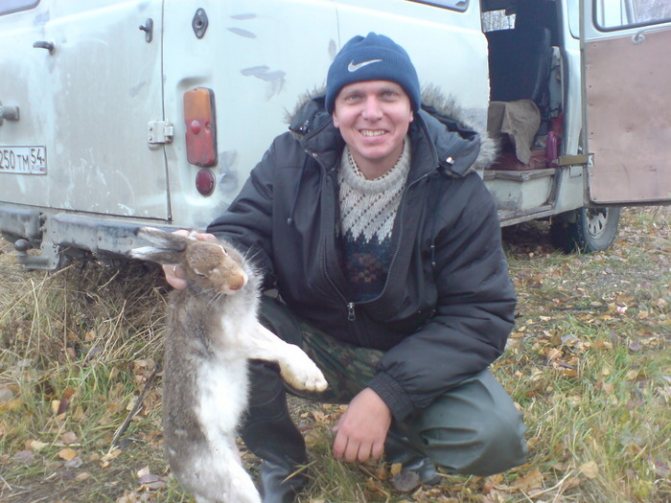
Everyone has their own favorite hunts. Some people go on African safaris every year to look for trophy animals, while for others, a holiday is the opportunity to wander through abandoned fields with a gun.
And if such a hunter is lucky enough to see an animal or bird at least from afar, he will remember them for a long time.
Memory will return him to this moment. He will continue to play out all the circumstances, look for reasons for failure or, conversely, for unexpected luck.
So I, like my fellow hunters, return to the past almost every day. I remember past hunts. I summarize, analyze, write down. And now I want to share some experience of difficult, but very interesting and truly sporting hunting for hare. Hunting along the black trail without hunting dogs alone.
Such hunting is common in the southern regions of Russia, where snow rarely covers the ground for a short time. Therefore, hunting hares, foxes, and raccoons is mostly done along the black trail.
Such hunts can be successful, but always involve hard work. You have to walk for hours on arable land melted under the sun, freeze in the cold wind that penetrates everywhere, walk in wet clothes through bushes, reeds, and thick grass.
And all this sometimes just to see a hare running loose in the distance.
If you nevertheless decide to engage in such a hunt for hare, study their lifestyle and habits. To do this, read hunting literature, talk with local hunters, study the places of upcoming hunts. You will have to take into account the weather and wind direction.
Expert opinion
Smirnov Alexander Stanislavovich
Wilderness survival instructor. More than 15 years of teaching experience
The hare in each area has its own habits and preferences. But there are also general points of behavior. At the beginning of the hunting season, it is often on arable land or in soft grass on the slopes of ravines and steppe rivers.
On the lower Volga, he took his first hares on arable land, where clumps of grass and tops of vegetable crops were preserved. In the Lviv region - in soft and dry fine plowing. In the Saratov steppes - in unplowed areas and from grass tongues.
Of course, to be successful, you must have the skill of identifying hares in the plowing field. To do this, you should inspect the road bordering it.
Rusaks, if there are any here, will use this road several times during the night. This means that with a careful study of the road, soft areas of arable land, roadside dust and dirt, you can find their traces.
The more tracks there are in the arable land, the greater the chances of a successful hunt.
It has been noticed that on arable land a hare rarely lies down near the road. Before digging a nest, the hare leaves marks in furrows or unplowed areas. Having made a small loop, the hare lies down with his head towards his mark. Often, when it sees a hunter, it hides and lets him pass.
Having determined the presence of hares in the field, 30–50 meters from the road, start moving against the wind.
It is better to go by shuttle with short stops. When you stop, make a little noise. Sometimes this is enough for a huge mermaid to suddenly appear on a field as clean as a sheet of paper and rush away from you.
In addition to arable land, the hare loves wide forest belts, gentle ravines, abandoned gardens and summer cottages.
In the lower reaches of the Volga, in the first days of the hunt, if it was not possible to raise a hare on arable land, he moved on to irrigation canals.
As a rule, hares in them lie on a sunny slope. You must walk along the sprinkler as carefully as possible, trying not to rustle through dry grass. Then you manage to get quite close to the hare. You have to shoot the rising hares from thirty paces away.
Before snow cover is established, hunting hares in forest belts is possible. For example, in wide forest belts of the Saratov region, hares often
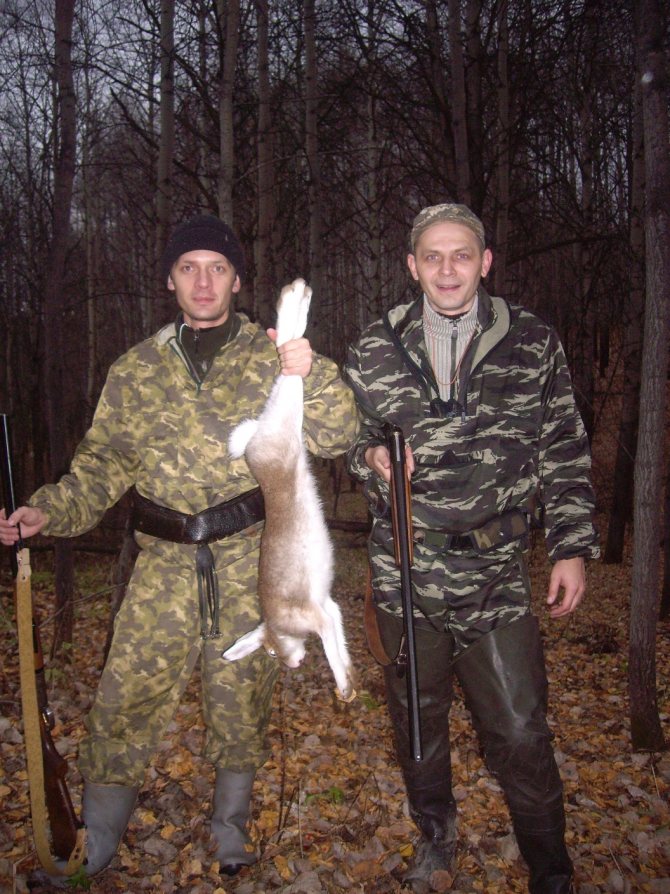
they fell off their beds, which were located closer to the edge and near the trunks of large trees.
The hare usually let the hunter pass, jumping up behind him and trying to go to the opposite side of the forest belt.
In the unplowed fields of harvested sunflowers and corn, we had to move slowly, with frequent stops. At stops you had to listen to where the animal rustled. It is noticed that the hare also stops for the same purpose.
If there are clumps of grass, reeds or weeds near the fields, they should also be examined.
An incident that happened to my father on one of the hunts remains in my memory. Having examined the field and not picking up a single hare, he went out onto the country road. Nearby there was a nursery fence, and between it and the dirt road there was about half a hectare of weeds. Deciding to take a shortcut, the father walked through the weeds. And in this small area he raised four birds with one stone, one after another.
A hare, if he settles in the forest, is in places that are more or less clean. Always avoids thickets and strongholds. In a continuous forest, a hare can only be found near the edges, clearings, and clearings.
This is interesting: Svinushka was previously conditionally edible, but is now classified as poisonous.
In the autumn, when the bushes are exposed, the hare leaves the bush, but returns with the onset of a thaw.
The hare avoids being in thick grass, reeds, on winter crops in the rain and with heavy dew.
During the first winter, hares fatten exclusively on winter crops or in fields with greenery. Hares rarely lie down in these fields, but, as a rule, they lie down near them.
When the first snow falls, the hare actively sheds its coat, putting on winter clothes. In the south, snow does not last long, and nature plays a cruel joke on it. The animal becomes more visible against the background of the dark earth. It becomes possible to hunt hare, as well as hare, “in the wild”.
During the years of warm autumn and winter in the Saratov steppes, it was possible to hunt hares from the approach. Such hunting on arable land is more effective. Using eight-power army binoculars, I studied the fields from a high place. Sometimes it was possible to spot the hare lying down and even approach for a confident shot.
If a hare lies on the plowed land, then its light gray fur gives it away. If the plowing is deep, then more often the hare lies in the furrow between the clods and is barely noticeable. If there are lonely trees, pillars, bushes, boulders on the field, then he tries to hide next to them.
The author managed to approach the hare while lying down to shoot. Almost until the very last moment there was no certainty that the bright spot on the dark background of the plowing was a hare. In the grass I accidentally came across a hare hiding by a stone. Moreover, the hare allowed him to approach almost closely, breaking away only at the last moment.
Sometimes, by going around the places where hares might have been fattened, it was possible to find a fresh trail. However, he got lost while plowing. In this case, a positive result was achieved using a simple technique.
Having followed the lost trail to the places where it could lie down, I seemed to cover the animal. He walked around a circle of steps 500–600 in diameter, making sure that there were possible lying areas left in the circle. If he did not find an exit trail, then the hare often found himself in a circle. Now the confrontation began. Who will notice who first: the hunter - the hare or vice versa.
You need to be especially careful when frost sets in, because... the sound of frozen grass and the creaking of snow are clearly audible, and the hare jumps off its perch far from the hunter.
But whenever and wherever you hunt a hare along the black trail, do not forget that you need to be constantly on alert, examining the entire space around you at 360°. Remember that a hare rises from a prone position with a jerk, in the wind, and in a matter of moments goes to a safe zone.
Expert opinion
Smirnov Alexander Stanislavovich
Wilderness survival instructor. More than 15 years of teaching experience
If the hare's shot did not stop, then it is necessary to continue monitoring the departing animal. More than once I had to witness that a hare, seemingly unaffected by the shot, fell dead after two or three hundred steps.
Therefore, if you believe that the hare is wounded, after a while, continue chasing it. A wounded hare hiding in a ravine, lowland or clump of grass should be pursued, allowing it to lie down for 40 - 60 minutes.
Then he lets you close.
Knowing some of its habits helps in chasing a wounded hare along a black trail. Thus, a hare, even when wounded, often, if not disturbed, does not go far from its place of daily residence.
To move from one field to another, he uses the narrowest isthmus. A ravine, the slopes of which are covered with bushes and sparse forest, the hare crosses along the cleanest place - along a gentle, wide slope.
A hare, moved from its bed, looks for a quiet place in a ravine, lowland, or irrigation canals. Therefore, if there were many hunters in the grounds, then in the afternoon I tried to avoid such places.
A lot has been written about the equipment of hunters on foot hunts. I agree that high rubber boots are best during autumn and winter thaws. In severe frost - felt boots. You need to dress in warm but light clothing that should not restrict movement.
To hunt a hare, the gun must have a sharp and precise action. It should be brought in line with winter clothing. The gun must fit well into the shoulder, which sometimes requires shortening the stock. Sometimes it is enough to remove the summer gaskets from under the shock absorber.
On the first hunts and in the thickets, you often have to shoot short, so it is better to use shot from the second number to the zero. In the right barrel - “two”, in the left - “zero”. In the wilderness, use shot in a container.
Last winter was warm, and the same is expected this year. Maybe the proposed techniques for hunting hares will be useful here and now. I will be happy about this.

Expert opinion
Smirnov Alexander Stanislavovich
Wilderness survival instructor. More than 15 years of teaching experience
Hare hunting is very popular today. There are quite a lot of ways to get it: tracking, “in the closet”, stalking, driving, etc., but, of course, hunting with hounds comes first.
It is based on the fact that hares, pursued by dogs, like foxes, escape from them along certain paths and holes. The hunter just has to choose the right place and make an accurate shot.
There are four species of hares in our country, only two of which are the main object of hunting - the white hare and the brown hare. The main points of the hunting technique with a hound are the same for both species, but due to the different lifestyles there are also their own characteristics.
Hare behavior in winter
In winter, hares do not hibernate, but continue to live in burrows and look for food under the snow (Figure 2). This feature makes winter hunting for them effective and efficient, and in some cases even like an exciting game.

Figure 2. In winter, hares lead a separate lifestyle
The best weather for going into the forest for a trophy is the time when the first snow falls, because the traces of an animal that has left its bed in search of food are clearly visible on it. Naturally, you can try to follow the animal's trail, but in most cases such an idea will lead to nothing: hares can reach speeds of up to 60 kilometers per hour, so you won't be able to catch up with them.
It is much more effective to find the animal’s habitat, set an ambush and wait for the time when the animal may appear. At the same time, it is important to behave very quietly, since the slightest rustle or noise can scare away the game. It is important to ambush against the wind, as hares usually sit downwind so that the air does not blow against their fur. By positioning yourself in this way, you will protect yourself from a situation where the animal senses you before you fire the first shot.
Features of winter hunting
Winter hare hunting, due to weather conditions, has certain features. First of all, you need to take care of your equipment, since getting a trophy involves not only constant movement through the forest, but also sitting in ambush for a long time.
Note: Clothing must be selected depending on weather conditions. For example, in the rain you will need a waterproof jacket, but it is better to travel long distances in the snow on a snowmobile. However, it should be taken into account that you will still have to walk to the animals’ habitat so that the noise of traffic and the smell of gasoline does not scare off the prey.
The importance of proper equipment is well known to hunters who hunt in Siberia. They can go into the forest for several days at once, so the equipment should include not only warm, waterproof clothing and shoes, but also a minimum set of food and water, a first aid kit, a thermos and a flashlight. If you have never hunted such a trophy before, the tips in the following sections will help you properly prepare for the hunt.
When and where is the best time to hunt?
In order for winter hare hunting to be truly successful, it is better to conduct reconnaissance in advance and determine the habitat or feeding areas of the animals. In the future, you can simply drive up to the desired location by car, select a location for an ambush and wait for the right time to shoot (Figure 3).
There are several tips for successfully hunting hare in the tundra or other hare:
- You need to shoot at the animal itself, and not at its shadow, which is always darker than the main silhouette.
- It is advisable to place the ambush shelter in such a way that it is located directly opposite the hare's path. In this case, the shadow of the animal will not prevent you from making a successful shot.
- If you have to shoot an animal in the back, it is better to aim for its upper body. However, this condition is relevant only if the animal has not begun to flee. If you need to shoot a running hare, it is best to shoot at the tips of its ears.
- The best time for hunting is early in the morning, or even better - dawn. At this time, the animals crawl out of their hiding places and, without feeling any sense of danger, go to feed.

When going to the forest, take an interest in the weather forecast in advance. For example, during heavy snowfall, animals become more cautious, and hitting game in a snowstorm will be very problematic. If heavy snowfall still finds you fishing, the best way to look for game is to plow. The rest of the time you can meet hares in ordinary open fields.
How to beat a young hound on a hare
Raising a hound should begin from puppyhood. By the time a dog should start hitting a hare - this is done from 10 months - it should be able to:
- come to the hunter at the sound of the horn;
- throw the prey on the command “Open!”;
- obediently follow the hunter without a leash;
- do not take food without command;
- do not react to pets;
- be accustomed to different soils and forests.
Remember! Training should not begin too early, before the hound has fully developed its musculoskeletal development. This will harm the dog's development.
The race takes place in areas where hares live. It is advisable that the area does not abound in animals, otherwise the young hound may simply become confused and not learn to untangle the tracks. Hare training is carried out from the end of April to the end of May.
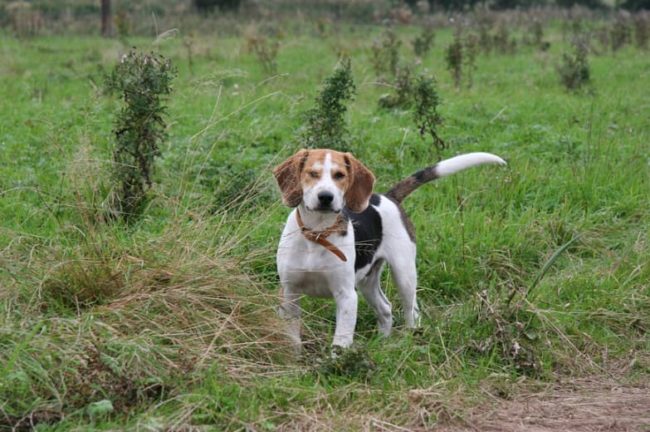
The first outings should be done for 2-3 hours a day so that the hound does not get tired. Experienced hunters advise carrying out the first training with an experienced dog, but after 2-3 joint trainings the hound should be allowed into a solo training.
The race should be carried out exclusively on black tops. If you train in the snow, the hound will get used to finding tracks visually, rather than using scent. When carrying out the training, you should encourage the puppy with the words “Come on, come on! Wake up! They increase the hound's excitement and show it where the hunter is.
Read more about how to hunt a hare with a dog.
The hound should be trained in different weather conditions, with the exception of rain, in different areas: meadow, open forest, thicket. A young hound, chasing a hare, will lose him as soon as he makes the first discount. In this case, to develop the viscosity of the hound, the hunter should encourage it with words, make it run around the lost track, so that it learns to untangle the hare's loops.
Varieties of winter hare hunting
Many people think that winter hare hunting comes down only to the fact that the hunter constantly walks through the forest, hoping to find a trace of the animal or the animal itself. In fact, the movement of hunters through the forest has a certain logic, because they are not just looking for traces of hares, but also their supposed habitats or feeding places.
There are quite a lot of types of hunting, and each of them has its own characteristics and rules, following which you can get a trophy without much difficulty. Next, we will look at their main features so that novice hunters can choose the preferred method of hunting game.
Trailing
Hare hunting by tracking is considered one of the most exciting types of hunting. The essence of this method comes down to correctly reading and deciphering animal tracks. Accordingly, the key role in this case is played not so much by the selection of the right weapon, but by the hunter’s endurance, his ingenuity and the skills of a tracker (Figure 5).
Note: Hares are very good at confusing their tracks, so when going trail hunting for the first time, it is better to take a more experienced hunter with you who will help you read the tracks correctly.
Hunting by tracking is carried out only if snow has recently fallen. This will make the task much easier, since you will not get confused in the tracks previously left by the animal. As a rule, during the daytime, hares rest in their burrow and only in the late afternoon come out to feed, leaving footprints in the snow. You can use them to track the animal.

Figure 5. You can track an animal by its tracks
Since hares like to run around after eating and further confuse their tracks, it is better to immediately follow the path of tracks and find the animal’s burrow, wait for its appearance and make an accurate aimed shot. It is difficult to track the animal using circular tracks, and only an experienced fisherman can cope with this task.
Out of hiding
If the snow layer is small, or you go hunting at the end of winter, when the snow cover begins to melt, the best option for obtaining a trophy would be to hunt a hare from ambush. In addition, at the end of winter it is already very difficult for animals to find food and, despite their caution, they come closer to human habitation (Figure 6).
Since this type of hunting involves waiting for the animal to appear, you will have to build a shelter:
- Build a structure similar to a snowdrift from compressed blocks of snow.
- You can use a white tent, which will not stand out in the area.
- If there is a stack of straw or selenium nearby that is not too frozen, you can use that too.
The most advantageous shelter is considered to be a haystack, since hares, in search of food, often get very close to them. If you set up cover here, you will have a much better chance of shooting game. That is why this type of hunting is most often recommended for beginning hunters.

Figure 6. The location for the ambush must be chosen very carefully.
If you don’t have the opportunity to build a permanent shelter, you can easily put on a camouflage robe and sit on an ordinary folding chair. However, it is better to take a position from the side of the hare path, so that it is more convenient to aim at the animal, and the prey does not smell you ahead of time.
In addition to the proper organization of the hiding place, you should also take into account the habits of the animal itself. Remember that hares are predominantly nocturnal: they spend the day in a hole, and in the evening they begin to emerge from the shelter in search of food. Therefore, it is better to set up an ambush in the evening or even at night.
Note: Many people worry that it will be difficult to hit the animal in the dark. In fact, in moonlight, reflected from even a minimal amount of light, a hare can be seen just as well as during the day.
There is a secret that all experienced hunters use. They divide the hare hunt into three nights: on the first night they look for and read the tracks, on the second they check the feeding area, and on the third they actually hunt. In addition, you can place bait in the feeding area, which will help attract more animals and increase the chances of getting a trophy.
With a dog
Hare hunting in winter with hounds is also very popular. The fact is that these dogs know the tracks of animals very well and can quickly lead the hunter to the prey (Figure 7).
Note: Running away from the dog, the hare makes a circle and still returns to its original place. Therefore, the hunter can only wait for the animal to return and make a well-aimed shot.

Naturally, for hare hunting with a dog to be effective, the assistant must be properly trained. Fortunately, training for hare hunting is not difficult. The most important thing is to teach the dog not to be distracted by other animals, for example, by a fox, which may come into the hound’s field of view while hunting a hare. In addition, hunting with a husky involves rewarding the animal: be sure to let the dog taste the taste of hare meat. This way she will have an incentive to catch up with the animal and will not lose interest in hunting.
With loops
There are quite effective ways to hunt a hare without a dog. One of the most effective is using loops. They can be installed either as an independent structure or in combination with traps or other fishing devices (Figure 8).
Note: Please note that this fishing method is not permitted in all regions, so be sure to check local legislation before heading into the forest.
Catching a hare with loops has certain features:
- It is advisable to tie the trap to a thin and flexible tree so that the animal, once caught in the loop, cannot escape.
- If the loop is equipped with a lift, it is desirable that the animal suffocate quickly: then it will not tear the structure.
- It is better to place the loop in such a way that the hare gets into it with his head. Based on this, experienced fishermen recommend installing traps over a fallen tree.
- To guarantee a trophy, it is advisable to install structures directly on hare trails. They are very visible in winter, as the animals usually run along the same route.
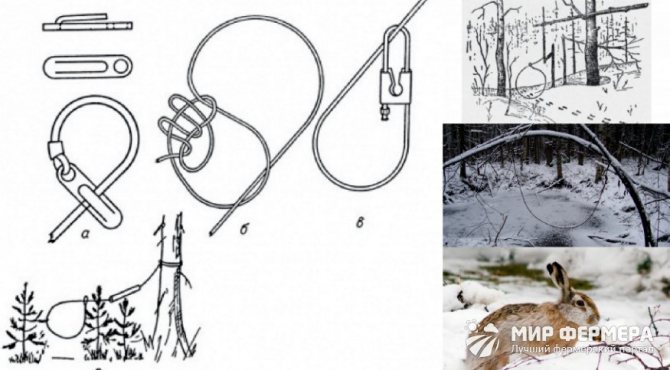
It is also important to consider that the loop should be almost invisible. To make it, it is better to use thin wire: it does not stand out in the surrounding landscape, but at the same time is quite strong. Immediately before installation, be sure to wipe the wire with any fragrant herb growing in the forest to eliminate the metallic smell.
From the approach
Hunting a hare in winter from the approach is the most common way of catching this game. But at the same time, fishing will be successful only if the weather outside is windless and with high humidity. In the summer, such weather promotes almost silent movement through the forest, and in the winter it helps to track down the hare spending time in a hole (Figure 9).
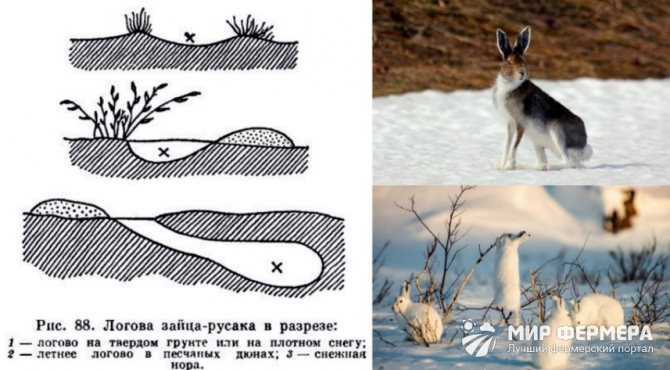
Figure 9. Hunting from the approach involves studying the habits of the animal
Despite the popularity of this method, you should be prepared for a sudden shot, especially in an open space, because the game can get scared and jump out of its cover at any moment.
With traps
Traps can also help catch a hare, but this method of catching is not in great demand among hunters who prefer to catch game in more interesting ways. However, this method should still be considered, since it is often used in regions where catching hares with snares is prohibited.
They begin setting traps immediately after the first snow falls, and it is advisable to use traps with large numbers. This is due to the fact that hares have very strong paws. However, it should be taken into account that the trap should not have a spring that is too tight, which could break the animal’s limb (Figure 10).
Note: As a rule, hunters install pressure and walk-through traps, but you should be prepared in advance for the fact that after them you will have to spend a lot of time masking traces.
Like loops, it is advisable to treat traps. For example, in the forest they can be rubbed with pine needles, and in the field with wormwood, but even without such camouflage, hares are unlikely to pay attention to the metallic smell.
In order for the prey to be accurately caught in the trap, the trap must be installed correctly:
- Selecting a location: It is advisable to set traps after snow has fallen. Traces of the animals will be clearly visible on its surface, and you will be able to easily determine the place of their feeding. This is where one or more traps should be placed.
- Trail traps: usually set along the trail of a hare at the turn of the path along which the animals follow to the feeding area after leaving the holes. This way, the likelihood of the animal falling into a trap will be much higher.
- Camouflage: To prevent the hare from noticing the structure, you need to carefully cut out a layer of snow, set a trap and return the snow to its place.
- Bait: selected depending on the breed that is most often found in a certain region. For example, white hare loves to eat aspen, especially the one that has been lying around for a while. You can also use birch or rowan branches covered with oats or snow. Browns love hay and straw more, and feast on branches mainly at the end of winter. You can use any vegetables as bait, or pour a weak saline solution over the bait.

When installing a trap, be sure to keep in mind that white hares are much more careful than brown hares, and it will be more difficult to catch them.
In addition, it is necessary to take into account that with a sufficient amount of natural food, hares are unlikely to go out into the open space, therefore it is better to place traps where animals are more often found.
Hunting with a dog
If we talk about choosing a dog for hunting a hare, then they mainly use hounds that know the tracks of hares and follow them well. Dogs vocalize if they come across a trail. Thus, the hunter knows by sound where the dog is. Running away from the dog, the hare makes a circle and returns to the same place where the hunter is waiting for him. Hare hunting with dogs can be considered the most popular, as it involves excitement and movement.
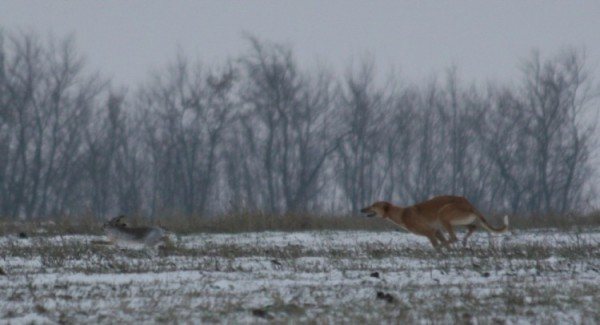
Breed selection
To hunt with a dog, you need to make the right choice. There are several dog breeds that have a high chance of success.
Of course, the best breed for hunting a hare with dogs is a hound, but you can still choose which breed. In our country, the most famous are three breeds of hounds: Russian hound, Russian piebald hound, Estonian hound and other species.
Let's take a closer look at the breeds:
- Estonian hound. Its main difference is that it is small in height, up to half a meter, and this is a big disadvantage when hunting in the snow. This breed is popular in countries with mild climates. And her advantage can be considered that she can easily live in an apartment.
- Anglo-Russian or Russian hound. These two breeds are almost identical in character traits. The Anglo-Russian hound is smaller in size, so it is less likely to knock off its paws when running. And Russian hounds have a more subtle sense of smell, so they often work on one type of animal. Russian hounds are more careful, although much depends on which kennel the puppy was taken from. Hunting with Russian hounds is the choice of most hunters.
- Greyhound dogs. A distinctive feature of these dogs is that when chasing an animal, they do not make a sound and their hunting goals are slightly different. The greyhound works for the hunter, which is why such hunting is often called “lazy”.
- Coping breeds. Many hunters choose this breed for its anger. That is, during a hunt, the dog, having discovered a hare, takes a stance and waits for a command, and the hunter at this time must shoot.
- Likes. Hunting a hare with a husky is advantageous because, when trained, it can very quickly find the prey by smell and “drive” it under the hunter’s bullet.
In order for hare hunting with hunting dogs to bring true pleasure, the dogs need to be trained.
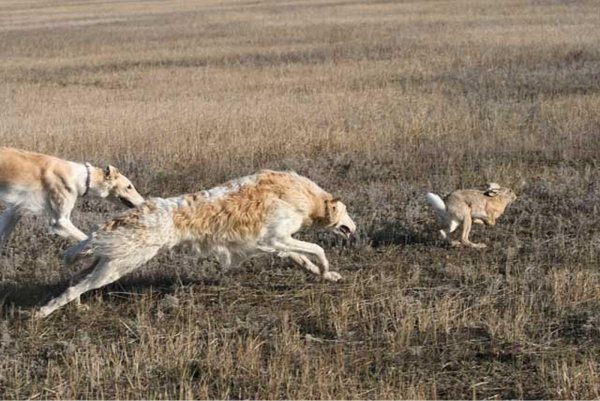
Dog training
Hounds undergo very strict training, although if you use the dog only for hunting hares, then the training will not be so difficult. It is important to teach the dog that if during a hunt, for example, he sees a fox, then his attention does not switch to a new animal.
During training, you must let the dog taste the hare so that it develops an interest in this animal. If the dog is not interested, the hare will easily slow down the pace of pursuit and she will get tired of the hunting process itself.
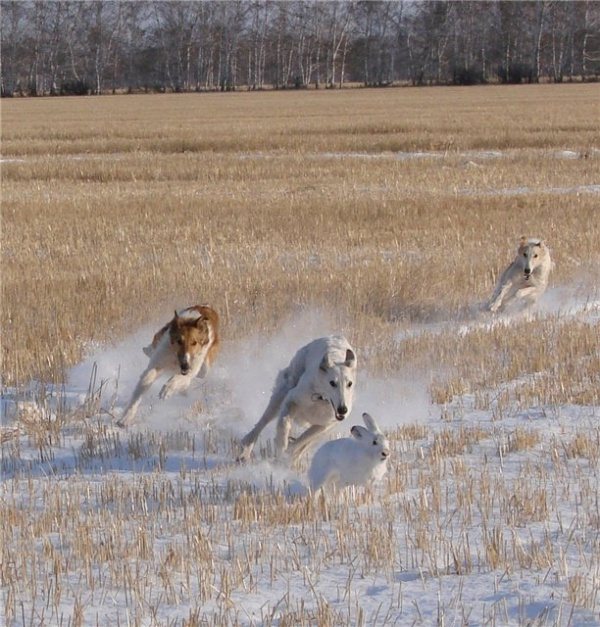
Searching for game: what a hunter should do
If you hunt with dogs, then there are rules for where it is better to look for animals. There is no point in looking for hares in the same places, because hares constantly change where they lie and feed. In wet times, it is better to look for hares on the hills, and in dry times - in the lowlands.
With dogs, the ideal time for hunting is the first snow or black trail. Hunting for a hare during the first snow consists of the fact that at such a time the alarmed animal runs around its resting place, and at this time the hunter fires a shot.
Another way is when the dog finds a place to lie down (in late autumn or during a thaw). The animal lies tightly pressed to the ground, and the hunter can calmly approach within shooting distance.
With the first snow, it will be easier for dogs to find animal tracks, which will increase the chances of a successful hunt. Hare hunting dogs will become indispensable assistants in any weather. The main thing is to obtain a hare hunting license before starting the hunting process, so as not to be fined for illegal actions.
Rules for searching for game
Experienced hunters recommend not going into the forest blindly, but following certain rules for searching for game. First of all, it should be taken into account that animals constantly change their places of lying and feeding. The choice of such a location is influenced by the weather: when it is damp outside, animals prefer to settle on high ground, and in dry weather - in lowlands.
Of course, the easiest way to search for game is with dogs, which can smell and scare away a hare. But it is better to go for such a fishery in the first snow. The alarmed animal will run around its bed, and the hunter will have the opportunity to make an accurate shot.
Differences between hare and hare tracks
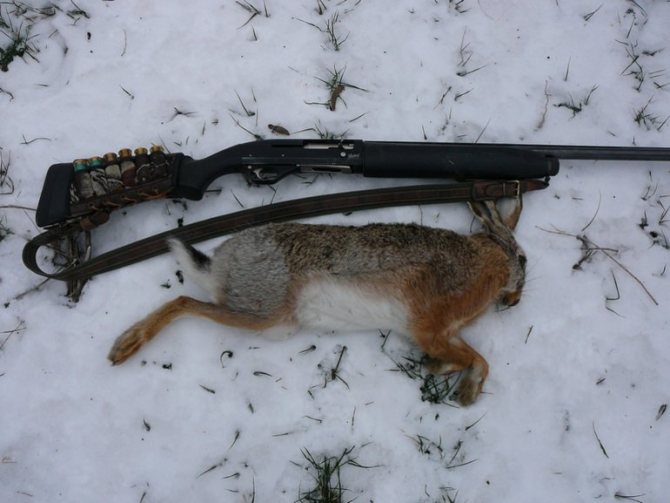
There are two main types of hares found in Russian lands: the hare and the hare. A representative of the first variety lives in forests, hiding in thickets of bushes. The animal feeds on twigs and tree bark. The hare loves open areas with a good view, prefers forest edges and beams. It feeds on grass, garden residues and winter crops, extracting them from under the snow.
Very often, animals have the same feeding places, and their tracks overlap each other. The white hare and the hare differ from each other in the structure of their paws, habits, places of lying and the manner of confusing their tracks. The hare's paw is somewhat narrower than that of the hare, and the toes are closer together. The white hare's print on the snow will have a round shape, and the hare's print will have an oval shape. Additional differences include the fact that the white hare has more intricate tracks.
Tips on how to untangle hare tracks
Finding the trail of a hare in the forest is not a problem, but deciphering it correctly can cause certain difficulties. The fact is that hares are extremely cunning animals and leave so many traces of their presence that an inexperienced hunter can easily get confused in them (Figure 11).
To properly navigate the hare trails, follow these tips:
- Try to walk not along the footprint itself, but next to it, so as not to accidentally step on the paw marks.
- Keep an eye not only on the snow, but also periodically look up to the horizon. Confusing its tracks, the hare often makes a circle and returns to its previous place to make itself a bed.
- Look not only at the trail, but also at the surrounding area, especially at places that can provide good cover: thick bushes, snowdrifts or hillocks.
- If you find a spot of fat, do not try to untangle a huge number of traces. Just walk around the location, find a single trail that comes out and follow it.
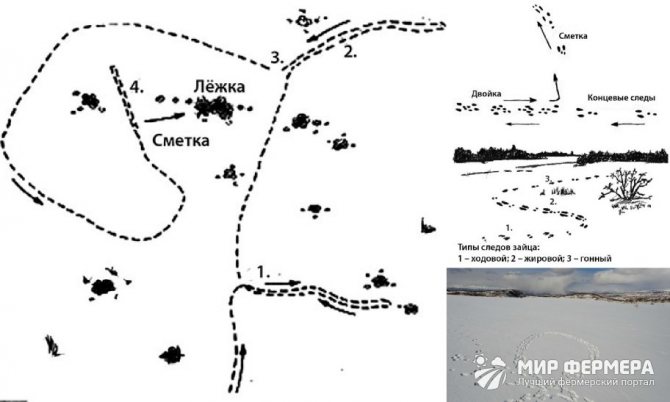
If at any point you find twos, threes and discounts, slow down and take a closer look at your surroundings. Such tracks mean that the hare’s resting place is already nearby and you can scare it away at any moment.
The process of tracking a hare
The night adventures of the hare are quite monotonous. At the beginning of the night, he emerges from his resting place, first carefully looking around, and then in fairly quick leaps he goes to the feeding areas. In feeding areas, it moves slowly in short leaps, very chaotically (confused). Between feeding areas, its running speeds up and the length of its jumps increases. Sometimes, on bright, quiet nights, hares begin to frolic and race in the snow, then their jumps become especially long.
After having a snack at the end of the night, the hare heads to its daytime bed. In the process , he begins to confuse the trail in order to confuse possible hunters . His run either speeds up or slows down, he can retrace his steps and then run on. He can go back a little and make a strong jump to the side and run further. Makes loops, runs out onto established paths and other people's paths, etc. During such a journey, the hare, depending on experience, performs each of these maneuvers from one to three times and only after all this hides in its shelter.

place of fattening
The process of unraveling all the nightly adventures of a hare, usually from the place of fattening (feeding) to the very place where it lies, is tracking. They start tracking by walking along the edge of a field or meadow, along forest paths or just along a country road, looking out for a hare's trail. Usually, hare paths lead towards fields and the like in the direction of the bedding area, and from there to thickets and bushes - to the bedding area.
The direction of movement of the hare is indicated to us by its hind paws; their prints are larger, more elongated and located in front of the prints of the front paws. If we are lucky enough to immediately find a trail leading from the feeding areas to the bedding area, go untangle it, otherwise head to the feeding area and start tracking from there.
Types of hare trails (maliks)
All hare tracks can be divided into four types: fatty, rutting, end and hare tricks like twos, threes and discounts.
Fat trace
The hare leaves it, moving slowly, in short jumps, usually while feeding or looking around. The distance between the front and hind legs is small, and the track itself in the areas of fat is very tangled, winding, can intersect with the tracks of other hares, and is often accompanied by hare droppings. The fat monograms are usually not untangled, but after going around the fat spot in a circle, they look for the escape trail when the hare goes to bed, and then follow it.

Racing trail
The hare leaves a rutting trail when he gallops at full speed. He can either run away from someone or simply frolic, rushing back and forth. The distances between jumps are large, sometimes up to two meters, the front legs are parallel to each other, the distances between the front and hind legs are greater than during walking. The racing trail at the end is replaced by a small fatty trail or a slower running trail.
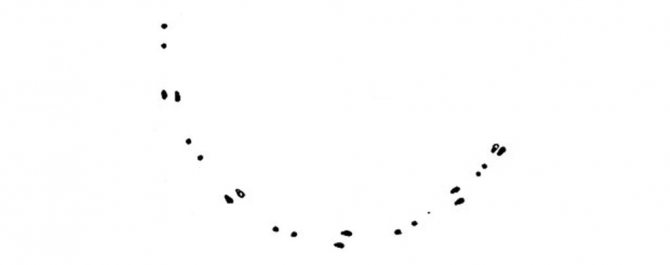
Running (end) trail
When the hare goes home from the fattening area to the resting place, its trail from the fattening area moves to a more purposeful, but still leisurely running (trailer). The distances between jumps increase, and the prints of the front paws follow one after another. It is this trail that is the most important, since it leads to the place where he is hiding. Actually, it’s only on him that the hare’s “arts” begin, loops, discounts, twos and threes, with which he tries to confuse you and prevent you from getting to his bed. The walking trail, especially of a hare, can run along well-trodden paths and roads, intertwined with the tracks of other hares and other animals, in this case you need to walk along and look for where the hare has gone to the side.

Twos, threes and loops
Walking along the running trail, you will encounter hare loops, twos and threes. This indicates that you are getting closer to his bed.
A loop appears when the hare, having made a circle, returns to its trail, crossing it or walking back a little along it. Loops usually appear closer to the bed, so when you see it you need to be more careful.
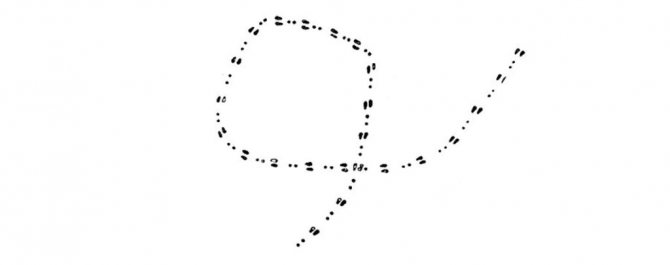
A deuce is when the hare, having run forward, returns a little back along its trail, and then abruptly changes direction, making a discount or simply changing the direction of running.

A three occurs when the hare, having walked back along its trail, nevertheless decides to move further in the original direction and again follows its path. After a three, there is usually no discount and the oblique after it is rarely sent to the prone.
Discounts (estimates)
A jump is a big jump that a hare makes away from its tracks. A discount is usually made after a deuce, and the direction of movement after it usually changes sharply to perpendicular to the previous one. On the way to the shelter, the animal rarely makes more than three discounts or two discounts. Usually after the second it’s time to start turning your head in all directions, looking for the hare.

Unraveling the maliks
So, what does the whole process of tracking a hare look like? Having found its trace (malik), we first determine its direction so as not to come to a previously abandoned bed. You can recognize it by fingerprints or by the position of the front and hind paws and the distance between the tracks, remember that a hare's hind paw prints are in front of the front ones. We head along the small road we found, a little away from it, so as not to trample it. If he led you to the fattening site, we go around this place in a circle in search of a waste trail; you should not waste time untangling the fattening loops.
Having found a departure, we begin to follow it, it will either lead to a new fattening site, or double loops and discounts will begin, which indicates the proximity of the hare's bed. The loops must be completed completely, otherwise there is a chance of getting lost and following the trail of another hare crossing the one you are looking for. If a malik came out onto a path, road or other trail and walked, or even merged with them, walk along this path three hundred to four hundred paces, in one direction and the other, until you find the meeting place. You can identify a fresh print against the background of old ones by lightly pressing it with your finger; the snow on the fresh one will crumple, whereas on the old one it will not.
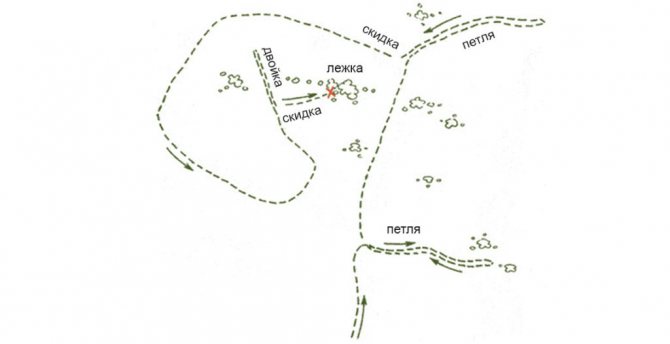
Remember places where you can get lost, trail intersections, etc. you may have to go back there. Usually after the first loops threes, twos and discounts begin. You should be wary after the first two at a discount, and after the second you need to look around in all directions and be ready to shoot. Experienced hunters say that when tracking a hare you should never stop. Even if you need to look around carefully, walk in place; your stop may provoke the oblique to rush out of the shelter. If you cannot specifically determine the location of the bedding, begin carefully, walking in a circle around the intended area of its placement, looking in the direction of the track

Lying place
How to find a resting place? You need to pay attention to those places where the hare likes to hide. The hare prefers to hide in places with a good view, in bushes scattered across the field, in the roots or near the trunks of trees on hills, at the base of snowdrifts and sediments, in ruts, hollows, near shelters such as barns, old huts or fences. During the early snow, the white hare can hide in the bushes near fields and on the edges, in heavy snow in the forest, deeper, in spruce forests, dense thickets, at turns, near windbreaks, sometimes along the edges of forest clearings.
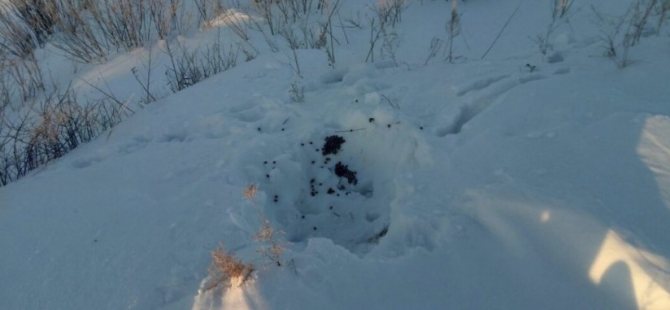
hare lying down
The resting place can be determined by a pile of snow, often different in color, with lumps of earth, which the animal scattered while digging a hole for itself. But it is worth considering that, in search of a good bed, he can sketch several such slides in different places.
When you notice a hare lying down, do not look directly at him, this will provoke him to jerk, watch out of the corner of your eye, and do not approach directly, but passing a little to the side. When you get to the place where it lies, try to shoot it on the spot. If you pick up a hare, you need to shoot after him. After the shot, watch the hare carefully. If he continues to run but behaved strangely, follow his trail, he may well be wounded and, without even leaving a drop of blood, he will collapse after running 300 - 400 meters. If you still miss, you don’t need to immediately track down the runaway hare, you still won’t keep up with him, and he will lead you until the evening. It’s better to hide and wait, he may well, after cutting a few circles, return to lying down or simply calm down and lie down in another place, then drag him out again.
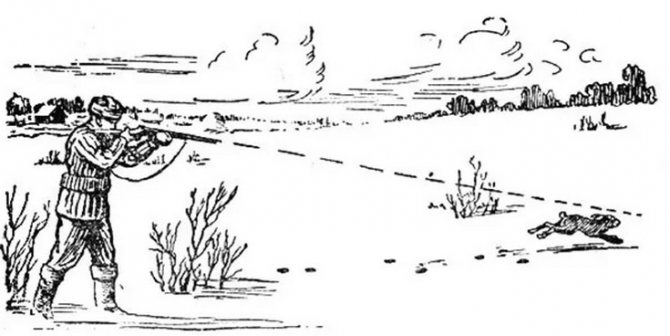
How to shoot an animal correctly
Hares are very fast animals, so you should be prepared for an unexpected shot. In addition, you may not have enough time to aim well, so it is best to familiarize yourself with the tips that will determine successful shooting in advance.
Firstly, you need to remember that the silhouette of the animal itself is always lighter than its shadow, so you need to aim at a lighter place in the snow. Secondly, when shooting from possible cover, it is better to position yourself so that the trail of the hare's trail goes towards your ambush. Then the shadow will interfere with a well-aimed shot.
In addition, you need to know which part of the body to aim for. If you come to a distance sufficient to shoot, it is better to aim at the upper part of the body, and if the animal starts to run away, then it is better to shoot at the tips of its ears. If a situation arises in which an animal runs straight at you, aim for its front paws.
How to shoot a hare?
For hare hunting, my friends and I usually equip cartridges with shot numbers 3 and 1. The first shot from a half-shot (cylinder) is a cartridge for short distances.
Usually this is a cartridge with number 3 shot, without a wad container, and in some cases (where you have to shoot quickly and short, for example near farms and in gardens) - a dispersant. The second shot is a long-range cartridge: shot number 1 in a wad container.
The desired gun is light and well adjusted to the hunter.
Expert opinion
Smirnov Alexander Stanislavovich
Wilderness survival instructor. More than 15 years of teaching experience
I am against the early opening of hare hunting. Apparently, the concept that has been deposited in my head since childhood that you can follow hares and foxes from the beginning of November does not allow me to think differently.
I am against the early opening of hare hunting. Apparently, the concept that has been deposited in my head since childhood that you can follow hares and foxes from the beginning of November does not allow me to think differently.
For example, in the current season, hare, fox and wolf can be hunted from September 15. It’s possible, but is it necessary? But what about the deciduous plants that are just emerging at this time? So, shooting a nursing hare will not be a violation of hunting rules?
In my opinion, this only benefits those who like to chase animals from under the headlights, so that a hare in the trunk of an SUV is not a reason to draw up a report. I don’t even want to talk about the quality of fox skins in September. That’s why I took the vouchers, but I’m going duck and woodcock fishing, which really is the right time!
However, even in November, the discovery of fur-bearing animals did not always take place along the white path. But not everyone knows how to find a hare when there is no trace.
Of course, the easiest answer to the question of where you can raise a brown hare is: everywhere! I had to drive him out from under a pile of broken slate, from the rubble of bushes, from under a combine broken in the field, from under the porch of an abandoned house. The Russians jumped out from under the diesel fuel tank, from the windows of the old cowshed, from under the barge rusting on the shore.
And yet I am used to looking for a hare in more typical places.
If I have to hunt alone, I go combing the slopes of ravines covered with burnt grass. Moreover, the hare can settle down for the day both at the top edge and at the very bottom. There is no need to rush here; you need to carefully check all the “suspicious” places, not being lazy, “hook”, stopping for a short time.
I was repeatedly convinced that the hare, lying very “tightly” at this time, jumps out exactly at the moment when the hunter stops. If you have binoculars with you (and everyone should have one when hunting in open areas), you should periodically inspect the surrounding area.
There are a lot of interesting things to see! In addition to the opportunity to admire a mousing fox and a flock of black grouse perched on a lonely birch tree, binoculars will eliminate unexpected encounters with competitors.
If on my way there is a field with deep plowing, and even interspersed with straw, I will certainly turn into it. Yes, of course, it is very inconvenient to walk along it, but it is precisely on such a field that the hare rises most often.
And even such a bright and seemingly noticeable animal as a fox flies out of deep plowing literally from under your feet. Then you’re just amazed – how did you not notice it before?!
Russians love to lie down in dry field marshes. It is here, among the hummocks covered with withered vegetation, that its reddish skin is completely invisible. From a swamp measuring 150 by 100 meters, our company was lucky enough to once raise four birds with one stone! True, that was twenty years ago, but that was
The hare is a great master of mimicry. Wherever the scythe settles down for the day, his “outfit” will certainly blend in with the surrounding area.
In different weather, the behavior of a hare while lying down varies significantly. In calm, clear weather with a slight frost, it easily flies out of the rest, sometimes out of range. As always, the hare strives to get up, seizing the moment when the hunter turns his back to him. Only a light rustle of dry grass can serve as a signal that the beast has risen.
In cloudy, windy weather, and even with precipitation, the hare needs to be “picked out” from its resting place with a boot. Everyone in our company remembers the incident when, while approaching a duck swamp, one of our friends stepped on a hare. Ooo! You just have to imagine it: waist-deep grass, everyone is careful, so as not to make noise, sneaking towards the swamp.
The reeds are about to burst with the “applause” of duck wings, and you will need to instantly identify the target and hit it with a well-aimed shot. And at that very moment my foot lands on something living, which instantly jumps a meter off the ground! A cry of amazement, a hasty, hectic, harmless doublet, and the culprit of the commotion himself, running away as fast as he could across an open field.
And of course, choice swearing that justifies the involuntary fear, and healthy, tearful laughter from the participants in the action.
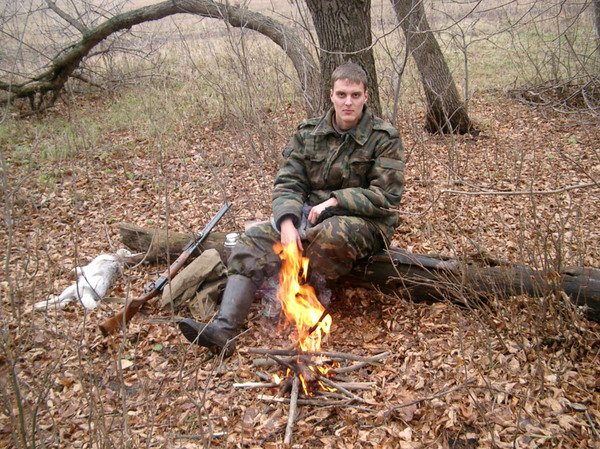
Seeing a hare lying down is the greatest luck. With forty years of hunting experience, I managed this only three times.
For the first time, when I was a boy running to my native Dubrovo, I saw a hare lying down on the very edge of a meadow swamp. I didn’t have a gun with me, since the youth hunting license had an entry: “The hunt should be carried out under the supervision of my father,” and this was sacredly observed.
So I crept up to the hare ten meters and joyfully clapped my hands. The hare took off running, and I was very proud of myself that I was able to sneak up on the hefty hare for a sure shot.
The second time, through the powder, we trailed the big-eared ones with our friend Mikhail. The trail approached a small pile of straw and disappeared.
This is interesting: Fire in the apartment: causes and your actions
I climbed onto it and saw a little little mermaid hiding right at my feet. And the third time this happened in the same Dubrovo, which is a ravine with a river and alder and oak groves.
I noticed a hare in a hole between two oak trees. He jumped out instantly as soon as my gaze settled on him.
If you hunt in a group, the chances of getting a hare up the black trail are much greater. There are two main methods: chain and corral.
Both the first and second methods have their pros and cons. By combing open areas and ravines, it is possible to cover a large area.
In addition, you are always in the zone of visual contact, and all events happen before your eyes. Often, a hare picked up by one of the hunters is shot by a partner.
But if the hare managed to realize in time that the danger did not come from one source (and this happens quite often), he manages to escape safely.
When hunting in a pen, a hare that leaves without a shot (or after a miss) is more likely to be shot by other members of the team. For the drive, we (when hunting with three of us) drop off (pick up) one beater at the beginning of the intended segment (the same ravine), and we ourselves go 3–5 kilometers further.
We block all promising openings of the animal and patiently wait for the beater. With this method of hunting, the fox becomes our prey more often than a hare.
If there are dogs, they, of course, go with the beater.
Expert opinion
Smirnov Alexander Stanislavovich
Wilderness survival instructor. More than 15 years of teaching experience
I really like abandoned villages for such hunting. There are quite a lot of these in our times, and the hare (just like the fox) willingly stays in them. It is in such places that you can enjoy the work of hounds.
People may object to me: what about the forest? After all, the most wonderful black trail hunt is in the forest! Yes, everything is so (it once was)! Of course, in the absence of snow, the hare walks under the hound in small circles. But where is he - the white hare? In my opinion, he cannot withstand competition with a wild boar.
You can, of course, say that epizootics are to blame for the decline in hare numbers, but I believe it’s pig farming!
Where can you find forests where you will be allowed to hunt white hare with a hound? Here's to the wild boar - please! I know hunters who, having acquired a license for a wild boar, which justifies being in the forest with a weapon, hunt a hare.
But this has nothing to do with the stated topic of the article.
Trying hare meat, sewing excellent white mittens or simple sporting interests - these and other goals guide avid hunters. But do not think that the hare will wait under the nearest pine tree and calmly allow itself to be found.
On the contrary, these animals have extremely acute vision, capable of catching the most imperceptible movements of their pursuers, and a pair of fast paws. So hunting hares is not only an exciting activity, but also quite difficult.
Fortunately, numerous generations of hunters of these eared creatures also did not waste time and managed to invent a single effective way of hunting hares. In this article we will look at several methods of hunting without a dog.
One of the most popular is hunting by drive, that is, collectively.
Recommendations from experienced hunters
In order for the hunting of an animal to be successful, it is necessary to take into account the advice of experienced hunters. First of all, when going fishing, take into account the weather conditions. Calm weather with temperatures just below zero is ideal. It is also advisable to go into the forest on freshly fallen snow, on which the animal’s footprint will be better visible.
In addition, study the habits, types of tracks and habits of the animal in advance. This way you will have a better chance of finding prey without walking through the forest for a long time. If you are interested in the secrets of successful hare hunting, we recommend watching a video that outlines the main nuances of this hunt.
What should a good hound be like?
Intensive training, study, constant training of actions, commands, both the dog and the shooter, will be able to bring worthy results in the hunt. Undoubtedly, taking care of the health and physical fitness of a hunting dog is another essential factor for success. To answer the main question – what a good hound should be – let’s divide it into two components.
How to train a hound to chase a hare?
Here you should forget about laziness altogether, both yours and your dog’s. Good physical exercise is necessary for the dog - it will increase its strength and endurance of the body. Training should be varied - these surprises in a real chase will only help against the cunning actions of the big-eared animal.
Running in urban conditions over long distances is necessary for the shooter and the dog. The hunter will increase stamina and breathing capacity. The dog, in addition to this, will also “fill” its paw pads in training. It won't allow you to grind them down until they bleed in a hare chase through the wild. But everything requires harmony!
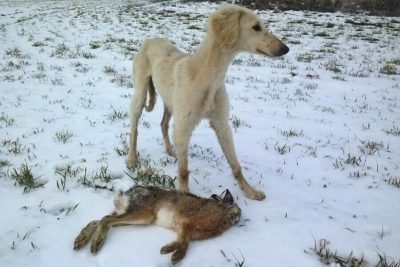
Especially in dog training. Don't be overzealous in improving her speed skills. It is better to increase monotony and ingenuity. It is known that a hare runs away even faster from a fast enemy. A steady, long pace can starve out the oblique one.
In general, the development of the dog’s health, alternation of tasks and exercises, excellent nutrition, medicine, care, and most importantly the love and care of the owner-hunter will turn even a previously frail hound into a real fast, smart dog.
Rules for driving a hound
The flair and ingenuity of a hound are inherent in nature. It is better if the breeder trains and educates these feelings. The acuity of smell will increase, which means the result will be more effective.
The main thing in any dog, especially in a hound, is discipline and 100% obedience to the owner. These breeds love to misbehave and play. This negatively affects the first trips for game. An undisciplined, spoiled dog does not listen to the owner’s commands, gets tangled in his legs, or, on the contrary, runs too far from the catcher.
To achieve this, discipline, obedience, and subordination are instilled by the breeder from puppyhood.
But for victories, praise and approval from the shooter is required. Only in harmonious reactions is the effect of symbiosis between a person and a dog possible during the rutting hare on autumn or winter days.
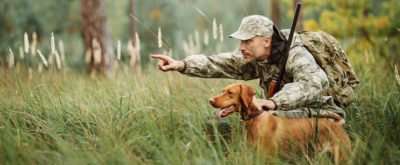
The process of training and learning the wisdom of hunting with a dog starts no earlier than 10 months from birth. With a dog that is too young, such stress is ineffective and dangerous for its health.
Masters choose the start of training for the hound in the spring. The hare's mating season is in full swing. The paths are thickly flavored with the odorous secretions of females. Scent helps novices learn their first lessons in stalking prey. Dawn will be the best time to study. The trails are not yet dry from the discharge.
Spring training ends without practice. Spring and summer are prohibited times for hunting with dogs.
Next, it is worth carrying out the surge in a specially designated place.
Autumn requires training for both the “young” hounds and the experienced dogs. According to experienced hunters during the “black-tropic” period, without snow the dog will get its paw on the game, remember its skills and “polish” them.
During the real rut, additional attention from the hunter is important for young dogs. Also at the moment of the animal’s fight. In a fit of euphoria, a young dog can eat wounded animals, which is absolutely unacceptable.
Collective driven hunt
To hunt hares using the driven method, the brigade is divided into two groups: beaters and shooters. The first ones pass by the hare's beds with the maximum possible noise, tapping with sticks, twirling rattles with a loud cry. In this case, frightened hares rise from their beds and run straight to the numbers.
Hunting a hare in a chain a - chain; b - forest chain; c - chain with flanks; 1 - beater; 2 - shooter; 3 - hunt leader
It is best to hunt in this way in frosty autumn weather along the black trail: then the long-eared comrades sit very sensitively, ready to instantly leave their settled place - a feeding swamp, for example. But in warmer weather, white hares (they are hunted in early winter) are difficult to lift, and no amount of ratcheting will help.
In the midst of winter, hunters switch to hare, which like to make themselves comfortable somewhere in bushes, ditches overgrown with grass, or among stones. In such places it is quite easy to notice the danger.
Having attacked the hare's trail, and making sure that the tracks do not go beyond the shelter, the shooters and beaters surround the hare's shelter and take opposite positions. Well, then everything happens according to the old scheme.
Circular pen 1 - beater; 2 - shooter; 3 - hunt leader
They say, by the way, that the hare is very fast, while his white relative (phlegmatic, apparently by temperament), in absolutely no hurry, runs out right in front of the shooters, which they take advantage of. However, even not very smart hare can leave you with your nose if the hunters do not move in an organized manner, and “holes” appear in their chain through which the prey finds a way to escape. This occurs due to ignorance of the basic rules of behavior in a chain: navigate by the rear neighbor in the group, the distance between hunters should be no more than 60–70 meters, and so on.
Hunting alone can be done in several ways: from the approach and from ambush.
About the brown hare and his habits
The brown hare, a typical representative of the forest and forest-steppe fauna of Russia, is an interesting, intelligent animal that can camouflage itself well, confuse its tracks, and sometimes even fight back its pursuer. There is plenty of evidence of hare being successfully killed by birds of prey. Caught in a noose, an adult hare can easily tear open a jacket and break a soldier's belt with a blow from its hind legs with long claws. Hunting by tracking is a very exciting activity, even if the winner is the hare. If the hunter managed to track him down, unravel the entire tangle of tracks and make a successful shot, the hunt turns into a real triumphant action. But to do this, you need to know the animal’s habits, behavioral characteristics at different periods of time, and be patient.
The hare feeds at night, and during the day rests on a bed in a secluded place, having first thoroughly tangled its tracks. It prefers to feed in the fields; in late autumn, the hare can often be found in winter crops. The brown hare prefers to live in fields with copses, meadows and groves, while the hare is a forest dweller. With colder weather, with deep snow cover, the brown hare moves closer to human habitation, the white hare moves to aspen and willow young stands. The hare continues to feed on herbs and their seeds all winter, sometimes making raids on people's gardens and orchards. Haystacks in the meadows are his favorite feeding grounds. Only with very deep snow and snow crust does it switch to feeding on the bark of bushes and trees.
This is interesting: The most dangerous poisonous plants in the world

They also choose their daytime resting places differently. Whites, as forest dwellers, prefer to hide in windbreaks, dense undergrowth or bushes. The brown hare lies down for a day's rest at the border of the land, in copses, and on the edges of the forest. This also determines the way the hare escapes from its pursuers. The hare loves a good overview from his day, when ascending, he leaves in an open place where he can develop sufficient speed, and then changes his grounds. It skillfully uses protective lands, such as ravines, ravines, and thickets of bushes along the floodplains of streams.
